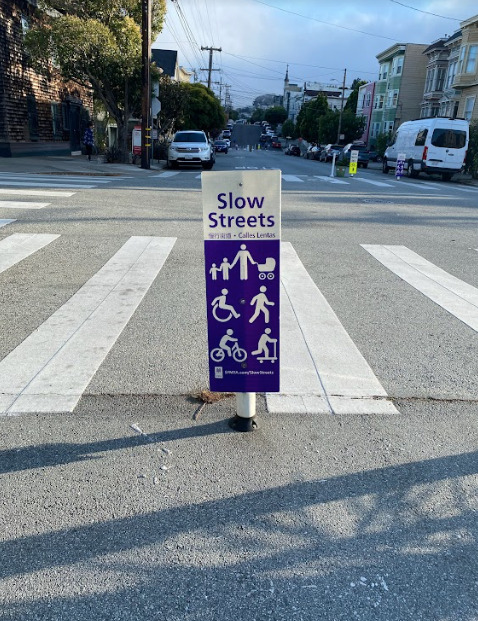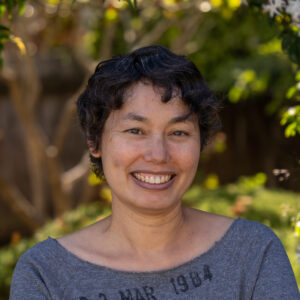As the early days of the pandemic move further and further into the past, what evidence is left of the shelter-in-place? Semi-permanent barriers still lie on many streets all around the city, marking San Francisco’s Slow Street program, one of the more obvious remnants from early shelter-in-place.
From the lack of access to public transport and therefore easy mobility around the city, to the need for six feet of distance, to the want for more outdoor public space, the spatial limitations of the pandemic begged for one simple solution: Slow Streets. The Slow Streets program is “designed to limit through traffic on certain residential streets and allow them to be used as a shared space for people traveling by foot and by bicycle” according to theSan Francisco Municipal Transit Agency (SFMTA) website. Amidst overwhelmingly negative news, this program brought a glimmer of much needed space to the San Francisco community. The program was simple — it blocked off relatively non-busy streets to through traffic. This made the city accessible to people cooped up in their houses with no way to move around during the pandemic.
Although it may have seemed done overnight, the process to choose and select the streets was actually quite complicated. San Francisco is a city filled with sloping hills, busy car areas and densely packed populations, so for SFMTA, picking a street where none of these things occurred was challenging.
One of the streets that checked off all these boxes was Sanchez Street. Even today, the street is closed for about 14 blocks. A group called Friends of Slow Sanchez banded together early in the Pandemic to help keep the Slow Sanchez Street program running. They promote community, safety and art. “[Friends of Slow Sanchez] was the key ingredient that made Sanchez so successful,” said Jacob Blintiff, the Legislative Aid for District 8 where Slow Sanchez is located.
“You can look at the whole city and see… Guerrero or Dolores are car streets, that is the predominant throughway for cars, you go to Valencia that is the main bike corridor, and the question is then what streets should be predominantly shared streets,” said Blintiff. Through this process, the city picked a few streets in late April 2020 to kick off the program.
In the beginning, many people were wary about Slow Streets. Originally, SFMTA received much feedback from people confused as to whether they could use these streets for through traffic. Others were annoyed and saw these streets as an inconvenience. However, once the idea became just another part of normal pandemic life, many people began to respond with positive feedback. Suddenly the inboxes of people at SFMTA were filled with suggestions for more Slow Streets, according to various city officials. Shannon Hake, the Transport Specialist of the SFMTA, said, “The day we announced the program we got a ton of emails of people saying ‘hey did you think of this street as a Slow Street?’ So we set up a comment forum to collect the suggestions and to date we have received over 8,000 responses to that forum.”
After dozens of Slow Streets were implemented all over the city, the question became one of equity. Once the recommended Slow Streets were implemented and SFMTA stepped back, they realized that the spread of Slow Streets were not actually that equitable. Hake said, “because we were essentially just using these crowd sourced suggestions… we were getting a lot of suggestions in areas where a lot of people who felt comfortable using the internet and making suggestions lived.” The city then stepped in to evaluate the situation and identified more streets throughout the city for the program to move forward.
At its core, the purpose of the Slow Streets program is to create more outdoor spaces for San Franciscans. Ana Herrera, the legislative aide for District 9 where Shotwell Street is located, said the program provides more “opportunities for children to learn to ride their bike on the streets, and for people in the neighborhood to be able to walk and use more than the sidewalk.”
People have varied opinions on whether an initiative designed for a pandemic belongs in a more and more post-pandemic world.
To people such as Maricar Lagura, Slow Streets have been more than beneficial. Lagura opened her business, Noe Cafe, during the height of the pandemic on Slow Sanchez. “Slow Streets really augmented the support of the cafe,” Lagura said. Running groups would stop at her cafe more frequently and she was able to expand onto the sidewalk.
Lagura has been in Noe Valley for 12 years but has never seen the neighborhood like this before. “Slow Streets benefit [the community], provide safer outlets, more eyes on the street and give a wonderful vibe through the whole neighborhood,” she said.
While Lagura, various city officials and many residents are in agreement about the benefits of Slow Streets, not everyone is convinced. Lisa Janssen, a dog trainer living on Slow Sanchez, said, “I find it very challenging maneuvering in and out of my garage and dealing with entitled pedestrians who apparently do not like drivers.” For her and others, Slow Streets are simply an annoyance and relic left over from the pandemic.
Many Lick-Wilmerding High School students are slightly confused on the purpose of Slow Streets in a post-pandemic world. A San Francisco Resident Theresa Pham ’24 said, “In the pandemic [Slow Streets] were super great because people went running, but now everyone is not doing anything so it is kind of pointless.”
Regardless of the varied views, Slow Streets are likely to become more permanent in some form or another. A permanent Slow Streets program will ultimately create a San Francisco where one could bike or walk through the city without dealing with issues posed by cars. Blintliff said, “It would be nice to be able to go all the way from point A to point B on a Slow Street. But it is really hard to do because of hills. But that is our goal moving down the road.”
The SFMTA will eventually vote on which streets will be part of a more permanent program. Their meeting was scheduled for October, however recently got pushed back until December after SF elections are over.
In whatever form it takes, the Slow Streets program will continue to coexist in the daily lives of San Franciscans. As Herrera said, “It is just really great to have car-free spaces.”






